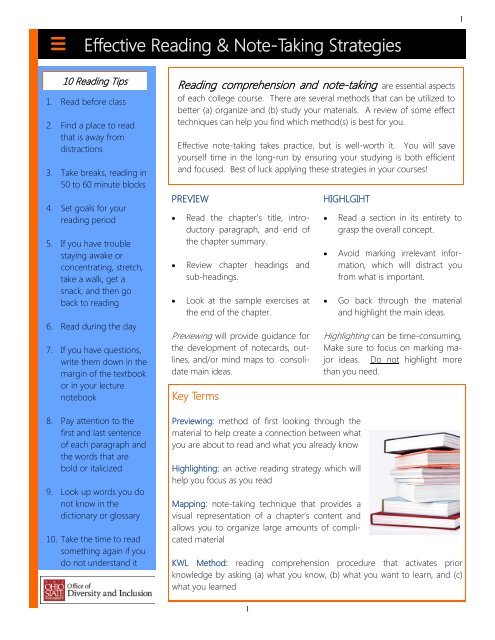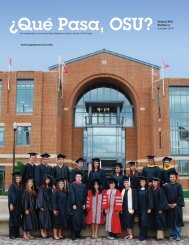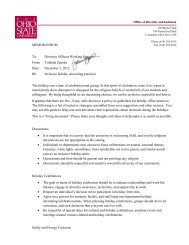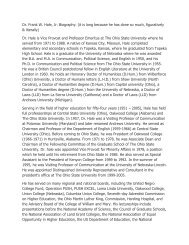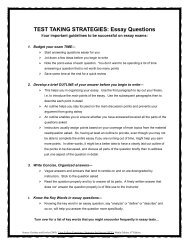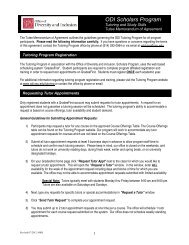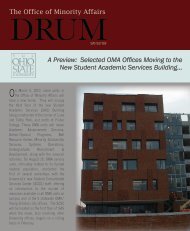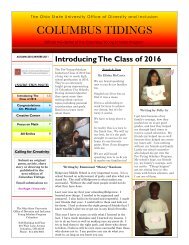Effective Reading & Note-Taking Strategies
Effective Reading & Note-Taking Strategies
Effective Reading & Note-Taking Strategies
Create successful ePaper yourself
Turn your PDF publications into a flip-book with our unique Google optimized e-Paper software.
1<strong>Effective</strong> <strong>Reading</strong> & <strong>Note</strong>-<strong>Taking</strong> <strong>Strategies</strong>10 <strong>Reading</strong> Tips1. Read before class2. Find a place to readthat is away fromdistractions3. Take breaks, reading in50 to 60 minute blocks4. Set goals for yourreading period5. If you have troublestaying awake orconcentrating, stretch,take a walk, get asnack, and then goback to reading6. Read during the day7. If you have questions,write them down in themargin of the textbookor in your lecturenotebook8. Pay attention to thefirst and last sentenceof each paragraph andthe words that arebold or italicized9. Look up words you donot know in thedictionary or glossary10. Take the time to readsomething again if youdo not understand it<strong>Reading</strong> comprehension and note-taking are essential aspectsof each college course. There are several methods that can be utilized tobetter (a) organize and (b) study your materials. A review of some effecttechniques can help you find which method(s) is best for you.<strong>Effective</strong> note-taking takes practice, but is well-worth it. You will saveyourself time in the long-run by ensuring your studying is both efficientand focused. Best of luck applying these strategies in your courses!PREVIEWRead the chapter's title, introductoryparagraph, and end ofthe chapter summary.Review chapter headings andsub-headings.Look at the sample exercises atthe end of the chapter.Previewing will provide guidance forthe development of notecards, outlines,and/or mind maps to consolidatemain ideas.Key TermsHIGHLGIHTPreviewing: method of first looking through thematerial to help create a connection between whatyou are about to read and what you already knowHighlighting: an active reading strategy which willhelp you focus as you readMapping: note-taking technique that provides avisual representation of a chapter’s content andallows you to organize large amounts of complicatedmaterialKWL Method: reading comprehension procedure that activates priorknowledge by asking (a) what you know, (b) what you want to learn, and (c)what you learnedRead a section in its entirety tograsp the overall concept.Avoid marking irrelevant information,which will distract youfrom what is important.Go back through the materialand highlight the main ideas.Highlighting can be time-consuming,Make sure to focus on marking majorideas. Do not highlight morethan you need.1
2<strong>Effective</strong> <strong>Reading</strong> & <strong>Note</strong>-taking <strong>Strategies</strong>MAPPING1. Write down the major ideas.2. Under these areas, categorize secondary, and tertiary ideas.3. Use the branches of your map to connect concepts with one another.Mapping is a useful technique for both visual and read/write learners. Mapping techniques can be utilized when(a) previewing, (b) reviewing a textbook, or (c) taking notes for class.Wheel MapBranching MapTry to practice abranching map ofyour own:Additional note-taking tips:When taking in-class notes, use abbreviations to save both time and space. This can be especially helpfulin subject areas where specific terms are used throughout the lesson or course.Ask your Professor or TA for course notes to supplement the ones you took in class (if not already provided).This can be a good way to review and organize course materials before an exam.Different subjects may require different methods. For instance, major concepts and sample problemsmay be critical for your performance in math and physical sciences courses. Get a feel for the main ideaspresented by your Instructor as well as anticipating sample, exam questions.Remember to find a method of note-taking that works for you. Feel free to use the tips presented in thishandout and adapt to your preferred, learning style (e.g., mapping for visual learners).2
3<strong>Effective</strong> <strong>Reading</strong> & <strong>Note</strong>-taking <strong>Strategies</strong>KWL METHOD(1) Prior to reading, as yourself "What do I know?" and "What do I want to learn?"(2) After reading, ask "What did I learn?"The KWL Method (know-want-learn) is a useful way to skim the course material with a specific objective in mind.Asking these questions prior to reading is helpful in (a) isolating the major concepts and (b) anticipating potentialTHE CORNELL METHODDivide your note-paper into 3 sections1. <strong>Note</strong>-taking column2. Recall column3. Summary sectionRecall Column<strong>Note</strong>-taking Column<strong>Note</strong>-taking Column Use the right-hand side of your paper fornote-taking Keep your notes both meaningful and legible Feel free to use abbreviations Use spaces to show division between ideasor major concepts To keep organized, date and number yourpagesRecall Column Draw a line 2.5 inches from the left side ofthe paper This column should be used for key wordsand phrases Try to summarize your Instructor's mainpoints into concise statements, summaries,and questions This column can provide you with a quickreference for studyingSummary SectionTutoring ProgramSummary Section Located at the bottom ofyour note-taking page Serves to help you summarizethe content of yournotesSAS Building, 3rd floor281 West Lane AvenuePhone: 614.292.8732Fax: 614.292.4798Email: odi-studyskills@osu.eduWeb: www.odi.osu.edu/tutoring3


